One sunny morning in Tehran, Neda was about to leave her apartment when she decided to make an extraordinary change to a very ordinary day. She walked out of her front door without covering her hair.
It was October, just weeks after the biggest protests since the Islamic Revolution erupted following the death in custody of Mahsa Zhina Amini, a young woman arrested by the religious police for allegedly violating the dress code. Neda had some errands to do.
“I was ridiculously jumpy, self-conscious and paranoid, anticipating the worst,” recalled Neda, who is in her 30s. “I was super watchful of everyone around me, searching for traces of open animosity.”
Neda is among the phalanx of women across urban Iran who are reclaiming autonomy over if, when and where they wear a hijab. As well as testing the legal boundaries, their quiet defiance is visibly transforming Tehran in a way that’s become the most immediate legacy of the latest revolt against the regime. And it’s not gone unnoticed by the authorities.
Since the overthrow of the shah in 1979, images of Iran’s capital have been defined by women clad in the thick, enveloping black chador, often framed beside one the city’s many murals calling for the downfall of the US. The past six months have completely turned that trope on its head.
Read the article by Golnar Motevalli in The Sydney Morning Herald.

